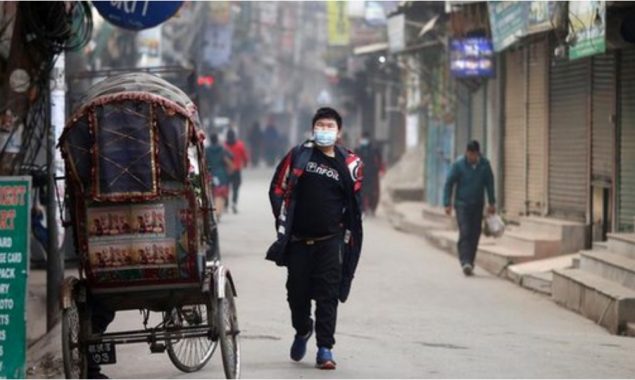
KATHMANDU – Kathmandu’s Bir Hospital, the largest in Nepal which was converted into a COVID-19 hospital, has witnessed growing hospitalizations in the past week. Meanwhile, major hospitals in the Kathmandu Valley all face rising hospitalizations along with surging daily infections since the start of the new year.
HOSPITALIZATIONS, TESTS GROWING Bir Hospital had 41 COVID-19 patients by Wednesday, up from 19 on Jan. 5.

source: WHO | World Health Organization
As more people are hospitalized, the number of people heading for COVID-19 testings also more than doubled last week. “About 80 to 100 people a day used to get tested for the coronavirus until a week ago, (but) the number has increased to over 200 a day,” Prajwol Shrestha, deputy director at Bir Hospital, told Xinhua. At Patan Hospital, another government-run facility in the Kathmandu Valley, the number of hospitalizations increased slightly.
“There are now around 35 hospitalized patients in our hospital from an average of 20 to 30 over the last few months,” said Ravi Shakya, director of the hospital. “Those coming for tests with PCR has increased to over 100 a day from 70 to 80.” Alarmingly, the positivity rate was 30-45 percent at Patan Hospital in the last few days, as against 3.69 percent nationwide reported on Wednesday by the health ministry.
The trends match a spike in new infections in Nepal. On Wednesday, 3,075 people tested positive for COVID-19, a record high since August 2021. The country has confirmed 27 Omicron cases since December. HEALTH FACILITIES IMPROVING The state of health facilities at Nepali hospitals came to the fore as a potential third wave of COVID-19 looms.
In May last year, when the second wave raged, hospitals were forced to turn away patients due to a lack of beds, oxygen and ventilators. This time around, major hospitals in the Kathmandu Valley said they are more than capable of accommodating an increasing flow of patients.
“We currently have 43 beds for COVID-19 patients and we can increase the bed number substantially as per the need,” said Shanta Kumar Das, coordinator of the COVID-19 management committee at Tribhuvan University Teaching Hospital. The hospital has a new oxygen plant with a capacity of 2,000 liters per minute.
“We also have set up liquid oxygen tanks with a capacity of 20,000 liters,” Das said. Patan Hospital is also equipped with a new oxygen plant and has set aside 110 beds for COVID-19 patients.
“The oxygen plant has the capacity of producing 260 cylinders a day,” Shakya said, adding more beds can be supplied over need. Bracing for another wave of the pandemic, Bir Hospital is making sure about increasing the supply of oxygen.
“We have the oxygen plant with a capacity of 150 cylinders per day, while we have separate liquid oxygen tanks with a capacity of 20,000 liters,” said Shrestha. Bir Hospital has a separate building that can house 500 beds for COVID-19 patients in the worst-case scenario.
“As many as 231 beds are currently functional,” said Shrestha. “Of them, 103 are high dependency unit beds and 100 are intensive care unit beds.”
Doctors, however, cautioned that improving health facilities at hospitals might not be enough to handle a growing number of patients due to the highly infectious nature of the Omicron variant, which is believed to have driven the new wave of infections. “We should not be overconfident about our facilities, even though Omicron appears to be less lethal than the Delta variant which drove the second wave last year,” said Shakya. Government officials said they were arranging the logistics over projected needs.
“A rapid action plan is being prepared to tackle a new wave of the coronavirus,” Surendra Chaurasiya, chief of the logistics management section of the Department of Health Services, told Xinhua.
“We’re making our logistical arrangement based on this plan. At least, there is little possibility of an immediate oxygen shortage.”
LACK OF HUMAN RESOURCES HIGHLIGHTED Bir Hospital has hired 55 more medical officers and 152 nurses for COVID-19 patients in case of the virus hitting again. “We need an additional 100 medical officers and 250 nurses if patients come to the full capacity of the 500-bed new building,” said Shrestha.
The hospital is coordinating with 21 provincial and other hospitals in different parts of the country. “I have heard of complaints about a potential shortage of human resources from most of these hospitals,” Shrestha said. Shakya said he has a similar concern, noting that there might be “a severe shortage of human resources if health workers are infected in numbers.”
Despite an abundant stock of vaccine doses, the Nepali government has failed to accelerate the vaccination drive starting in late January last year. As of Wednesday, only 37.8 percent of the country’s some 30 million population had been fully vaccinated.
The authorities have re-imposed some restrictive measures to curb the spread of the virus, including banning public gatherings involving more than 25 people, closing schools and colleges, and vaccinating students aged 12-17.
Read More News On
Catch all the Health News, International News, Breaking News Event and Latest News Updates on The BOL News
Download The BOL News App to get the Daily News Update & Follow us on Google News.




